Chapter: Cryptography and Network Security Principles and Practice : Network and Internet Security : Transport-Level Security
Secure Shell (SSH)
SECURE
SHELL (SSH)
Secure Shell (SSH)
is a protocol for secure
network communications designed
to be relatively simple
and inexpensive to implement. The initial
version, SSH1 was
focused on providing a secure remote logon facility to replace TELNET
and other remote logon schemes that provided no security. SSH also provides a
more general client/server capability and can be used for such network
functions as file transfer and e-mail. A new version,
SSH2, fixes a number of security flaws
in the original scheme. SSH2 is documented as a proposed standard in IETF
RFCs 4250 through
4256.
SSH client and
server applications are
widely available for
most operating sys- tems.
It has become the method of choice for remote login and X tunneling and
is rapidly becoming one of the most pervasive
applications for encryption technology outside of embedded
systems.
SSH is organized as three protocols that
typically run on top of TCP (Figure 16.8):
•
Transport Layer Protocol: Provides
server authentication, data confidentiality,
and data integrity with forward secrecy (i.e., if a key is compromised
during one session, the knowledge does
not affect the security of earlier sessions). The
transport layer may optionally provide
compression.
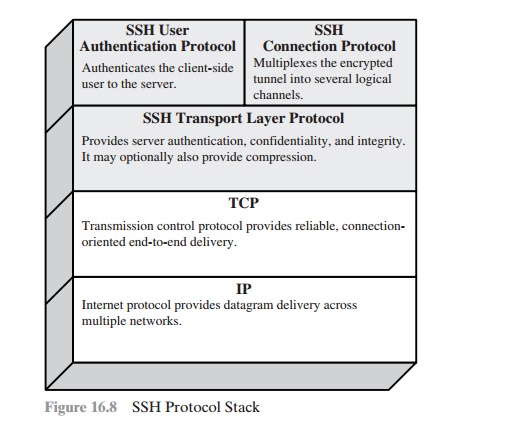
•
User Authentication Protocol: Authenticates the user to the server.
•
Connection Protocol: Multiplexes multiple
logical communications channels over a single, underlying SSH connection.
Transport Layer Protocol
HOST KEYS Server authentication occurs at the transport layer, based
on the server possessing a public/private key pair. A server may have multiple
host keys using multiple different asymmetric encryption algorithms. Multiple
hosts may share the
same host key. In any case, the
server host key is used
during key exchange to
authenticate the identity of the host. For
this to be possible, the client must have a priori knowledge
of the server’s public host key. RFC 4251 dictates two alternative
trust models that can be used:
1.
The client has a
local database that associates each host name (as typed by the user) with the corresponding public host key.
This method requires no centrally
administered infrastructure and no third-party
coordination. The downside is that the database of name-to-key associations may become burdensome to maintain.
2.
The host name-to-key association is certified by a trusted
certification author- ity (CA).
The client only knows the CA root key and can verify the validity of all
host keys certified by accepted CAs. This alternative eases
the maintenance problem, since
ideally, only
a single CA key needs
to be securely stored on the
client. On the other hand, each host key must be appropriately certified by a
central authority before authorization is possible.
PACKET
EXCHANGE Figure
16.9 illustrates the sequence of events in the SSH Transport Layer Protocol.
First, the client establishes a TCP connection to the server. This is done via
the TCP protocol and is not part of the Transport Layer Protocol. Once the
connection is established, the client and server exchange data, referred to as
packets, in the data field of a TCP segment. Each packet is in the following
format (Figure 16.10).
•
Packet length: Length of the packet in bytes, not including the packet
length and MAC fields.
•
Padding length: Length of the random
padding field.
•
Payload: Useful contents of
the packet. Prior to algorithm negotiation, this field is uncompressed. If compression is negotiated, then in subsequent pack- ets, this
field is compressed.
•
Random padding: Once an encryption
algorithm has been negotiated, this field is added.
It contains random bytes of padding so that that total length of
the packet (excluding the MAC field) is a multiple of the cipher block size, or
8 bytes for a stream cipher.
•
Message authentication
code (MAC): If message authentication has been negotiated, this field contains the MAC value. The MAC value is computed over the entire packet plus a sequence
number, excluding the MAC field. The sequence
number is an implicit 32-bit packet sequence that is initialized to
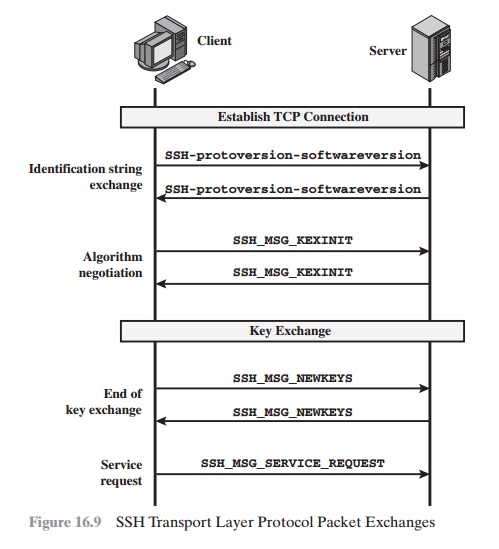
zero for the first packet and incremented for every packet.
The sequence num- ber is not included
in the packet sent over the TCP connection.
Once an encryption algorithm has been negotiated, the entire packet
(exclud- ing the MAC field)
is encrypted after
the MAC value is calculated.
The SSH Transport Layer packet exchange consists of a sequence of steps (Figure 16.9).
The first step, the identification string exchange, begins with the client sending a packet with an identification string of the form:
SSH-protoversion-softwareversion SP comments
CR LF
where SP,
CR, and LF are
space character, carriage return, and line feed, respectively. An example of a valid string is SSH-2.0-billsSSH_3.6.3q3<CR><LF>. The server responds with its own identification string. These strings are used in the Diffie-
Hellman key exchange.
Next comes algorithm negotiation. Each side sends an SSH_MSG_KEXINIT con- taining lists
of supported
algorithms in the order of preference to the sender. There is one list for each type of cryptographic algorithm.The algorithms include key exchange, encryption, MAC algorithm, and compression algorithm. Table 16.3 shows the allow- able options for encryption, MAC, and compression. For each category, the algorithm chosen is the first algorithm on the client’s list that is also supported
by the server.
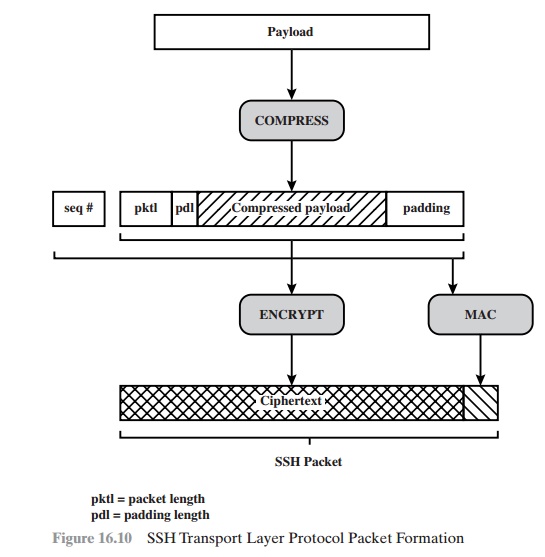
The next step is key exchange. The specification allows
for alternative methods of key exchange,
but at present, only two versions of Diffie-Hellman key
exchange are specified. Both versions are defined in RFC 2409 and require
only one packet
in each direction. The following steps are involved in the exchange. In this, C is the client;
S is the server;
p
is a large
safe prime; g is
a generator for a subgroup
of GF(p); q is the order of the subgroup; V_S is S’s identification string;
V_C is C’s identification string; K_S is S’s public host key; I_C is C’s SSH_MSG_KEXINIT message and I_S is S’s SSH_MSG_KEXINIT message that have been exchanged before
this part begins. The values of p, g, and q are
known to both client and server as a result of the algorithm
selection negotiation. The hash function hash() is also decided during
algorithm negotiation.
1.
C generates a random
number x(1 6 x 6 q) and computes e = gx mod p. C sends e to S.
2.
S generates a random
number y(0 6 y 6 q) and computes f = gy mod p. S receives e. It computes K = ey mod
p, H = hash(V_C
|| V_S || I_C || I_S || K_S
|| e || f || K), and signature
s
on H with its private
host key. S sends (K_S || f || s) to C. The
signing operation may
involve a second hashing operation.
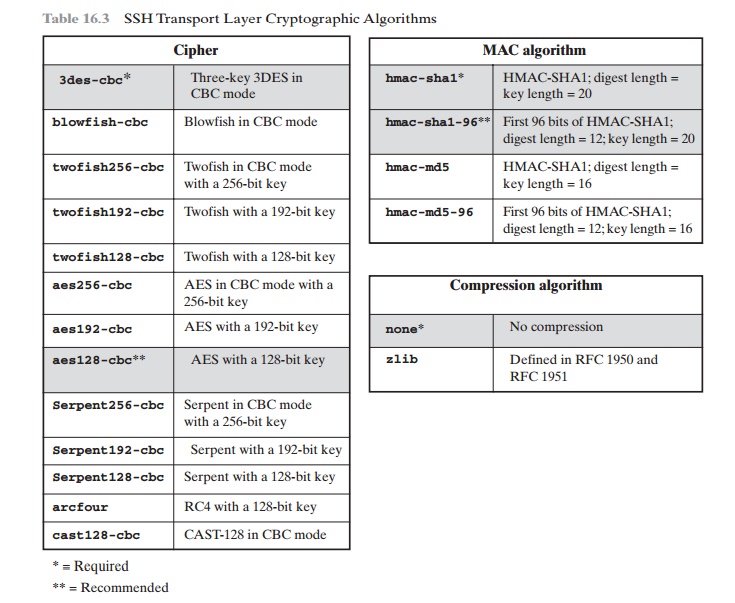
1.
C verifies that K_S really is the host key
for S (e.g., using certificates or a local database). C is also allowed to
accept the key without verification; however, doing so will render the
protocol insecure against active attacks (but
may be desirable for practical
reasons in the short
term in many environments).
C then computes K = fx mod p, H = hash(V_C || V_S ||
I_C || I_S || K_S || e || f || K), and verifies the signature
s on
H.
As a result of these steps, the two sides now share a master key K. In addition,
the server has been authenticated to the client, because the server has used
its pri- vate key to sign its half of the Diffie-Hellman exchange. Finally, the hash value H serves as a session
identifier for this connection. Once computed, the session identi- fier is not changed,
even if the key exchange
is performed again for this connection
to obtain fresh keys.
The end of key exchange
is signaled by the exchange of SSH_MSG_NEWKEYS packets. At this point, both sides may start using the keys generated from K, as dis- cussed subsequently.
The final
step is service request. The
client sends an SSH_MSG_
SERVICE_REQUEST packet to request either the User Authentication or the Connection Protocol. Subsequent to this, all data is exchanged
as the payload of an SSH
Transport Layer
packet, protected by encryption and MAC.
KEY GENERATION The keys used for encryption and MAC (and
any needed IVs) are generated from the shared secret key K, the hash value from the key exchange H, and the session identifier, which is equal to H unless there has been a subsequent key exchange after the initial key exchange. The values
are computed as follows.
•
Initial IV client to server: HASH(K ||
H
|| "A" || session_id)
•
Initial IV server to client: HASH(K || H || "B" || session_id)
•
Encryption key client to server: HASH(K || H || "C" || session_id)
•
Encryption key server to client: HASH(K ||
H
|| "D" || session_id)
•
Integrity key client to server: HASH(K ||
H
|| "E" || session_id)
•
Integrity key server to client: HASH(K || H || "F" || session_id)
where HASH() is the hash function determined during algorithm
negotiation.
User Authentication Protocol
The User Authentication Protocol provides the means by which the client is authen-
ticated to the server.
MESSAGE TYPES AND FORMATS Three types of messages
are always used in the User
Authentication Protocol. Authentication requests from the client have the format:
byte SSH_MSG_USERAUTH_REQUEST (50)
string user name string service name string method name
... method specific fields
where user name is the authorization
identity the client is claiming, service name is the facility
to which the client is requesting
access (typically the SSH Connection
Protocol), and method name is the authentication method being used in this request.
The first byte has decimal value
50, which is interpreted as SSH_MSG_USERAUTH_REQUEST.
If the server either (1) rejects the authentication
request or (2) accepts the
request but requires one or more additional
authentication methods, the server sends a message with the format:
byte SSH_MSG_USERAUTH_FAILURE (51)
name-list authentications that can continue
boolean partial success
where the name-list is a list of methods
that may productively continue the dialog. If the server accepts authentication, it
sends a single byte message: SSH_MSG_
USERAUTH_SUCCESS (52).
MESSAGE
EXCHANGE The
message exchange involves the following steps.
1.
The client sends a SSH_MSG_USERAUTH_REQUEST with a requested method of none.
2.
The server checks to determine
if the user name is valid.
If not, the server returns
SSH_MSG_USERAUTH_FAILURE with the partial success value of false. If the
user name is valid, the server proceeds
to step 3.
3.
The server returns SSH_MSG_USERAUTH_FAILURE with a list of one or more authentication methods to be used.
4.
The client selects one of the
acceptable authentication methods and sends a SSH_MSG_USERAUTH_REQUEST with that method
name and the required
method-specific fields.
At this point, there may be a sequence of exchanges to perform
the method.
5.
If the authentication succeeds and more authentication methods are required, the
server proceeds
to step 3, using a partial
success value of true.
If the authentication fails, the server proceeds
to step 3, using a partial
success value of false.
6.
When all required authentication methods succeed, the
server sends a SSH_MSG_USERAUTH_SUCCESS message, and the Authentication Protocol is over.
AUTHENTICATION METHODS The server may require one or more of the following
authentication methods.
•
publickey: The details of this method
depend on the public-key algorithm chosen. In essence, the client
sends a message to the server that contains the client’s public key, with the message signed
by the client’s private key. When the
server receives this message, it checks whether
the supplied key is accept- able for authentication and, if so, it checks whether
the signature is correct.
•
password: The client sends a message containing a plaintext password, which is protected by encryption by the Transport Layer Protocol.
•
hostbased: Authentication is performed on the client’s
host rather than the
client itself. Thus, a host that supports multiple
clients would provide
authenti- cation for all its clients.
This method works
by having the client send a signa- ture created with the private key
of the client host. Thus, rather than
directly verifying the user’s identity, the
SSH server verifies the identity of the client host—and then believes the host
when it says the user has already authenti- cated on the client
side.
Connection Protocol
The SSH Connection Protocol runs on top of the SSH Transport
Layer Protocol and assumes that a secure
authentication connection is in use.2 That secure authentication connection, referred
to as a tunnel, is used by the Connection Protocol to multiplex a number of logical
channels.
CHANNEL MECHANISM All types of communication using SSH, such as a terminal
session, are supported using separate
channels. Either side may open a channel.
For each channel,
each side associates a unique channel
number, which need not be the
same on both ends. Channels are flow
controlled using a window mechanism. No data may be sent to a channel until a
message is received to indicate that window space is available.
The life of a channel
progresses through three
stages: opening a channel, data transfer, and closing a channel.
When either side wishes to open a new channel, it allocates a local number
for the channel and then sends
a message of the form:
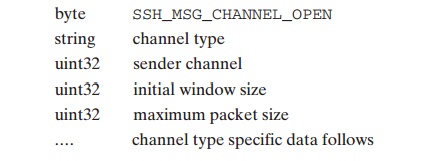
where uint32 means
unsigned 32-bit integer.
The channel type identifies the applica- tion for this
channel, as described subsequently.
The sender channel is the local channel number. The initial window size specifies
how many bytes of channel
data can be sent to the sender of this message without adjusting the window.
The maxi- mum packet size
specifies the maximum size of an individual data packet that can be
sent to the sender. For example,
one might want to use smaller packets
for inter- active connections to get better interactive response
on slow links.
If the remote side is able to open the channel,
it returns a SSH_MSG_
CHANNEL_OPEN_CONFIRMATION message, which includes the sender
channel number, the recipient channel number, and window and packet
size values for incoming traffic. Otherwise, the remote side returns a SSH_MSG_CHANNEL_ OPEN_FAILURE message with a reason code
indicating the reason for failure.
Once a channel is open, data
transfer is performed using a
SSH_MSG_ CHANNEL_DATA message, which
includes the recipient channel number and a block of data. These messages, in both
directions, may continue as long as the channel is open.
When either
side wishes to close a channel,
it sends a SSH_MSG_
CHANNEL_CLOSE message,
which includes the recipient channel number.
Figure 16.11 provides
an example of Connection Protocol
Message Exchange.
CHANNEL
TYPES Four
channel types are recognized in the SSH Connection Protocol specification.
session: The remote execution of a program. The program
may be a shell, an application such as file transfer or e-mail, a system command,
or some built-in subsystem. Once a session channel
is opened, subsequent requests are used to
start the remote program.
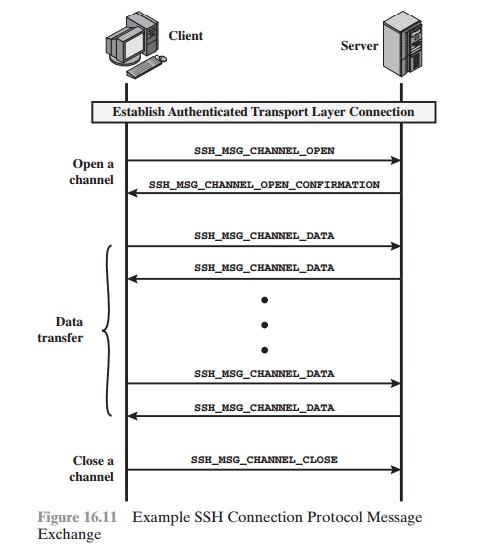
•
x11: This refers to the X Window
System, a computer
software system and net-
work protocol that provides a graphical user interface (GUI) for networked
computers. X allows applications to run on a network
server but to be displayed on a desktop machine.
•
forwarded-tcpip: This
is remote port forwarding, as explained in the next sub- section.
•
direct-tcpip: This is local port
forwarding, as explained in the next subsection.
PORT
FORWARDING One
of the most useful features of SSH is port forwarding. In essence, port
forwarding provides the ability
to convert any insecure
TCP connection into a secure SSH connection. This is also referred
to as SSH tunneling. We need to
know what a port is in this context. A port is an identifier of a user of TCP. So, any application
that runs on top of TCP has a port number. Incoming TCP traffic is delivered
to the appropriate application on the basis of the port number.An
application may employ multiple
port numbers. For example, for the Simple Mail Transfer Protocol
(SMTP), the server side generally
listens on port 25, so an incoming
SMTP request uses TCP and addresses
the data to destination port 25.TCP
recognizes that this is the SMTP server address and routes the data to the SMTP server application.
Figure 16.12 illustrates the basic concept
behind port forwarding. We have a
client application that is identified by port number
x
and a server application identi- fied by port number y. At some point, the client application
invokes the local TCP entity and requests a connection to the remote
server on port y. The local TCP entity
negotiates a TCP connection with the remote TCP entity, such that the connection links local port x to
remote port y.
To secure this connection, SSH is configured so that the SSH Transport Layer Protocol establishes a TCP
connection between the SSH client and server entities with TCP port numbers a and b, respectively. A secure SSH tunnel is established over this TCP connection. Traffic from the client at port x is redirected to the local
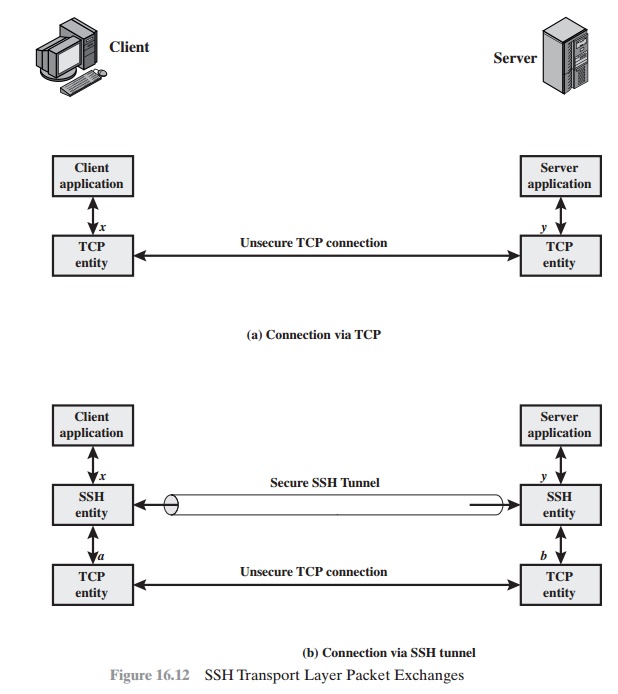
SSH entity and travels through
the tunnel where
the remote SSH entity delivers
the data to the server application on port y. Traffic in the other
direction is similarly redirected.
SSH supports two types of port forwarding: local forwarding and remote for- warding. Local forwarding allows the
client to set
up a “hijacker” process. This
will intercept selected application-level traffic and redirect it from
an unsecured TCP connection to a secure SSH tunnel. SSH is configured to listen
on selected ports. SSH grabs all traffic using a selected port and sends it
through an SSH tunnel. On the other end, the SSH server sends
the incoming traffic
to the destination port dic- tated by the client application.
The following example should help clarify local forwarding.
Suppose you have an e-mail client on your desktop and use it to get e-mail from
your mail server via the Post Office Protocol (POP). The assigned port number for POP3 is port
110. We can secure this traffic in
the following way:
1.
The SSH client sets up a connection to the remote server.
2.
Select an unused local port number, say 9999, and configure SSH to accept traffic
from this port destined for port 110 on the server.
3.
The SSH client informs
the SSH server to create a connection to the destina-
tion, in this case mailserver port 110.
4.
The client takes any bits sent to local port 9999 and sends them to the server inside the encrypted
SSH session. The SSH server decrypts the incoming
bits and sends the plaintext
to port 110.
5.
In the other
direction, the SSH server takes any bits received on port 110 and sends them inside the SSH session back to the client, who decrypts and sends
them to the process connected to port 9999.
With remote
forwarding, the user’s SSH client acts on the server’s behalf. The
client receives traffic with a given destination port number, places the
traffic on the correct port and sends it to the destination the user chooses. A
typical example of remote forwarding is the following. You wish to access a
server at work from your home computer. Because the work server is behind a
firewall, it will not accept an SSH request from your home computer. However,
from work you can set up an SSH tunnel using remote forwarding. This involves
the follow- ing steps.
1.
From the work computer,
set up an SSH connection to
your home computer. The firewall will allow this, because it is a
protected outgoing connection.
2.
Configure the SSH server to listen on a local port, say 22, and to deliver
data across the SSH connection addressed to remote
port, say 2222.
3.
You can now go to your home computer, and configure
SSH to accept traffic
on port 2222.
4.
You now have an SSH tunnel that can be used for remote logon to the work server.
Related Topics